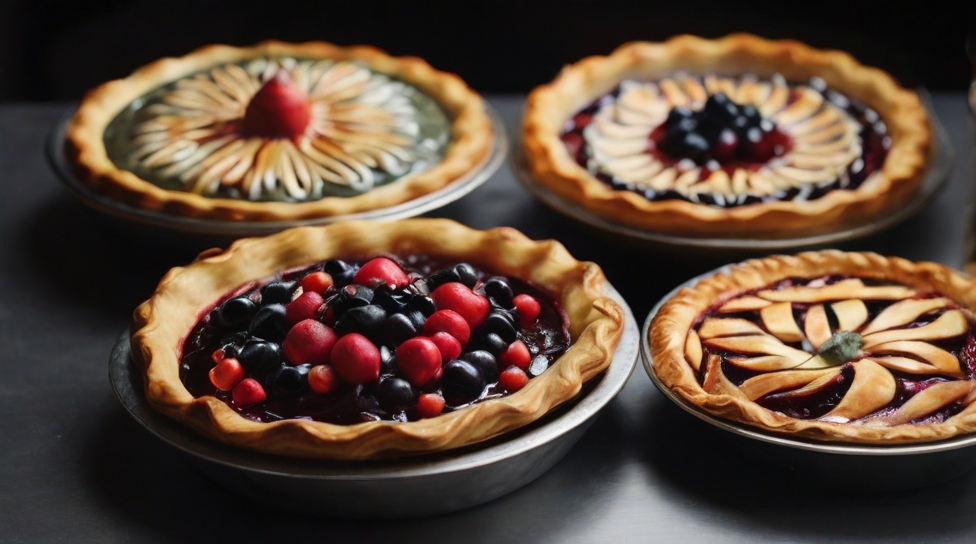Bake Like a Pro: Choosing the Right Pie Pan for Every Occasion!
From the classic apple pie that graces Thanksgiving tables to the savory pot pies that warm our souls on chilly evenings, the pie pan is the silent partner that transforms raw ingredients into a symphony of flavors and textures. But it’s not just about function; the pie pan is a canvas for creativity, allowing bakers to experiment with decorative crusts, lattice patterns, and even personal messages that add a touch of love to each creation.

Table of contents
Table of contents
Introduction
01. Types
02. Factors to Consider
03. Top Picks for Different Occasions
04. Maintenance and Care
05. Customer Reviews and Ratings
06. Exclusive Offers and Discounts
07. Expert Recommendations
08. Common Mistakes to Avoid
09. Personal Testimonials
10. Trends in Designs
11. Environmental Impact
Pros & Cons
Conclusion
Top 7 Pie Pans
FAQs
Introduction
Pie pans, also known as pie dishes or pie plates, are essential tools in any baker’s arsenal. These round, shallow containers come in various materials, each offering unique benefits. Choosing the right pie pan goes beyond aesthetics – it impacts the texture of your crust, the evenness of your bake, and the overall success of your pie-making endeavor.
01. Types
1.1 Traditional Metal
Metal pie pans are classic and widely used. They conduct heat efficiently, resulting in evenly baked crusts. However, they may not be ideal for all occasions due to their appearance.
1.2 Glass
Glass pie pans allow you to monitor the browning of the crust, but they may take longer to heat. They’re an excellent choice for fruit pies where seeing the filling is crucial.
1.3 Ceramic
Ceramic pie pans offer even heat distribution and an attractive presentation. However, they can be heavier and may require longer preheating.
1.4 Silicone
Silicone pans are non-stick and flexible, making them a breeze to clean. However, they may not provide the crispiness desired for certain pie crusts.
02. Factors to Consider
2.1 Size and Depth
Selecting the right size and depth ensures your pie has ample space for filling and allows for even baking. Consider the type of pies you frequently bake to determine the most suitable dimensions.
2.2 Material
The material affects the baking process. Metal pans are excellent conductors, while glass provides visibility. Ceramic and silicone offer their unique advantages, catering to different baking needs.
2.3 Heat Conductivity
Even heat distribution is crucial for a uniformly baked pie. Choose a pan with good heat conductivity to avoid undercooked or unevenly cooked sections.
2.4 Durability
Invest in a durable pie pan that can withstand frequent use and temperature changes. A durable pan ensures longevity and consistent baking results over time.
2.5 The Perfect Pie Crust
The crust is the foundation of any pie, and your choice of pie pan plays a pivotal role in achieving that perfect flakiness. Consider the following tips to elevate your crust game:
- Utilize chilled elements for a flakier surface
- Preheat your pie pan for a crisper crust.
- Experiment with different fats for unique flavors.
03. Top Picks for Different Occasions
3.1 Thanksgiving
For the grandeur of Thanksgiving, a deep metal pan is ideal for hearty pies like pumpkin or pecan. The depth allows for generous fillings, creating a dessert centerpiece.
3.2 Holiday Baking
During the festive season, a decorative ceramic pie pan adds a touch of elegance to your table. Choose festive colors or patterns to enhance the holiday spirit.
3.3 Everyday Use
For everyday baking, a versatile glass pie pan is a reliable choice. Its transparency allows you to check the doneness of the crust easily.
04. Maintenance and Care
4.1 Cleaning Tips
Proper care ensures the longevity of your pie pan. Avoid abrasive cleaners for non-stick pans, and always hand wash ceramic pans to preserve their glaze.
4.2 Storing
Stacking pans may lead to scratches and damage. Store pie pans separately or use protective layers to prevent wear and tear.
4.3 Budget-Friendly Options
Quality pie pans don’t have to break the bank. Many affordable options offer excellent performance, providing value for your money without compromising on results.
4.4 Affordable Yet High-Quality
Explore budget-friendly brands that prioritize quality. Online marketplaces often offer discounted bundles, making it cost-effective to stock up on reliable pie pans.
4.5 Value for Money
Consider the longevity of the pie pan. Spending a little more on a durable pan may save you money in the long run, as you won’t need to replace it as frequently.
05. Customer Reviews and Ratings
5.1 Importance of Reviews
Before making a purchase, delve into customer reviews to gain insights into the performance and durability of different pie pans. Real experiences can guide you toward the best choice for your baking needs.
5.2 Where to Find Genuine Feedback?
Look beyond the product page on online retailers. Social media groups, baking forums, and blogs often feature honest reviews and recommendations from fellow baking enthusiasts.
06. Exclusive Offers and Discounts
6.1 Best Deals
Stay updated on exclusive offers and discounts from reputable kitchenware stores. Many brands provide special promotions during baking seasons or holidays.
6.2 Limited-Time Offers
Act quickly when you spot a limited-time offer on premium items. Subscribing to newsletters or following brands on social media can help you seize these opportunities.
07. Expert Recommendations
7.1 Insights from Professional Bakers
Seek advice from seasoned bakers who have tested various products. Their experiences can guide you toward the best options for specific pie recipes.
7.2 Industry Favorites
Explore pie pans endorsed by professional kitchens or featured in baking competitions. These pans often meet high standards for performance and durability.
08. Common Mistakes to Avoid
8.1 Pitfalls in Selection
Avoid common errors like using the wrong size pan or neglecting to preheat. These mistakes can affect the overall quality of your pie.
8.2 How to Rectify Common Errors
If you’ve encountered issues with your pie crust or filling, troubleshoot by adjusting your baking temperature, experimenting with different fats, or consulting with experienced bakers.
09. Personal Testimonials
9.1 User Experiences
Discover personal stories from home bakers who have successfully chosen the right pie pan for their favorite recipes. Learn from their triumphs and challenges.
9.2 Success Stories in Baking
Celebrate success stories where the right pie pan elevated a simple recipe to extraordinary heights. These anecdotes inspire confidence in your own baking journey.
10. Trends in Pie Pan Designs
10.1 Modern and Stylish Options
Stay trendy with modern and stylish featuring innovative designs. From geometric patterns to vibrant colors, these pans add flair to your kitchen.
10.2 Customization and Personalization
Explore custom options, including engraved or personalized designs. These make for thoughtful gifts and add a personal touch to your baking.
11. Environmental Impact
11.1 Sustainable Choices
Contribute to a greener planet by choosing sustainable eco-friendly materials. Many brands are now prioritizing environmentally conscious production.
11.2 Eco-Friendly Alternatives
Consider alternatives to traditional disposables, such as reusable silicone options. These choices reduce waste and have a lower environmental impact.

1. Dishwasher-Safe Pans:
Learn about dishwasher-safe options for hassle-free maintenance.
2. Benefits of Each Material:
Understanding the benefits of materials like non-stick, glass, and cast iron helps in selecting the ideal pie pan for your baking needs.
3. Contribution to Even Baking:
Pie pans play a crucial role in achieving a perfectly baked crust. Learn how different materials contribute to even baking.
4. Retaining Warmth:
Discover how certain materials retain warmth, ensuring your pie crust is always golden and flaky.
5. Non-Stick Options:
Explore the convenience of non-stick pie pans and their impact on easy cleaning.

1. Materials Prone to Damage:
Identifying materials prone to damage or warping over time.
2. Challenges of Baking Larger Pies:
Exploring the challenges of baking larger pies in standard-sized pans.
3. Finding Alternatives:
Consider alternatives for special occasions when standard sizes may not suffice.
4. Price Variations:
Understanding the price variations among different pie pan materials.
5. Balancing Budget and Quality:
Tips on balancing your budget while ensuring the quality of your pie pan.
Conclusion
In the quest to bake like a pro, choosing the right pie pan is a game-changer. From traditional metal pans to modern silicone alternatives, the market offers a vast array of choices catering to different preferences and baking styles. Consider the factors that matter most to you – size, material, and durability – and let your pie pan enhance your baking experience. With the right pan in hand, you’re well on your way to creating delectable pies that will be the talk of every occasion.
Top 7 Pie Pans on Amazon
FAQs
Q1: Can I use any pie pan for baking?
A1: While you can use various pie pans, choosing the right one depends on your specific baking needs and preferences.
Q2: How do I clean my pie pan without damaging it?
A2: For non-stick pans, avoid abrasive cleaners. Hand wash ceramic pans to preserve their glaze.
Q3: Are silicone pie pans a good choice for all pie types?
A3: Silicone pans are versatile but may not provide the desired crispiness for certain crusts.
Q4: What’s the significance of preheating the pie pan?
A4: Preheating ensures a crispier crust by starting the baking process immediately upon placing the pie in the oven.
Q5: Can I stack my pie pans for storage?
A5: Stacking pans may lead to scratches. Store them separately or use protective layers to prevent damage.
You May also Like: WHY STAINLESS STEEL COOKING SETS ARE TAKING OVER?







